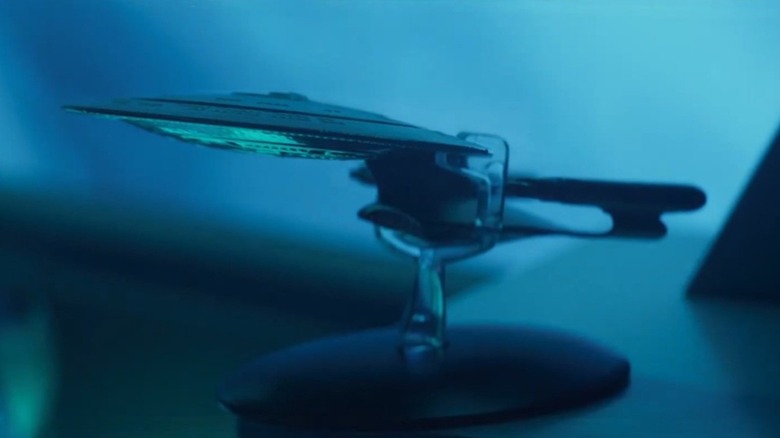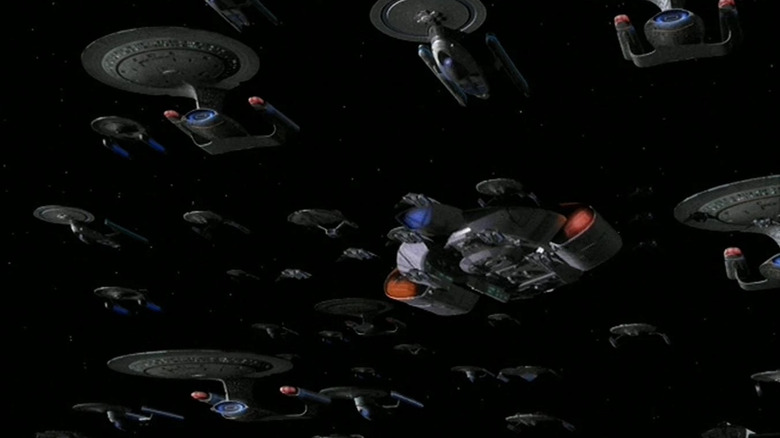Star Trek: Picard Season 3 Presents An Unpopular Opinion About A Beloved Ship
This post contains spoilers for the premiere of "Star Trek: Picard" season 3.
In the first episode of the third season of "Star Trek: Picard," Captain Riker (Jonathan Frakes) is drinking at Guinan's bar. The bar is recognizably retro, with familiar looking spirits on a glass shelf, booths for dining, and even neon signage advertising various beers. The only thing it's missing is a blinking sign declaring that Coors was FOR CaliFORnia. Riker is in town for an upcoming Federation holiday called Frontier Day, and he and Admiral Picard (Patrick Stewart) are scheduled to make inspirational speeches at celebratory event. While waiting in the bar, Riker notices that Guinan is doing something previously unthinkable: selling merch. The bar is heavily decorated with miniature scale models of recognizable Federation starships on stands.
The shelves, Riker notes, are awfully lousy with models of the Enterprise-D, the ship he served on for seven seasons of "Star Trek: The Next Generation." Guinan (Whoopi Goldberg, not appearing on this season of "Picard") also worked on the Enterprise-D for many years. The Enterprise-D was a Galaxy-Class starship, meaning it was quite large and suitable for families. Those who grew up watching "Next Generation" will likely be enamored of the ovals and curves of the Enterprise-D, along with its Jupiterian eye-shaped deflector. It's a much more elegant ship when compared to its more angular predecessor from the 1966 series.
For the moment, we will ignore the conceit that one would sell palm-sized souvenirs in a post-capitalist future with access to replicators. Why buy Guinan's souvenirs if 1. there is no money, and 2. you can make one yourself for free? This is not to be acknowledged.
The fat ones
Riker asks the bartender cautiously why there are so many models of the Enterprise-D. The other ships, it seems, are being distributed with more frequency. The bartender replies that "no one wants the fat ones." Riker, of course, is immediately miffed, wounded that his old workplace would be so dissed. He asks that the bartender pour him another and leave the bottle.
This old Trekkie did indeed grow up watching "Star Trek: The Next Generation," so it's difficult to offer any kind of legitimate criticism of the Enterprise-D's design. If one spends too many years looking at a starship, it sort of becomes a regular feature of your subconscious. It becomes difficult to imagine it coming out any other way. Anecdotally, I once polled any "Next Generation" neophytes to comment on the design, and one peer pointed out that it might seem a little "top-heavy." This is fair. The Enterprise-D's saucer section is, when compared to its drive section, quite enormous. It's like a flying saucer with a handle attached.
Of course, it's hard to imagine that anyone would reject the Enterprise-D over other notable "Star Trek" vessels. Does someone actually prefer the hand trowel-shaped Intrepid-Class U.S.S. Voyager over the Enterprise-D? Or the ugly-as-sin Sovereign-Class Enterprise-E, a ship that looks like it was left on a barbecue grill? Rejecting the Enterprise-D as "the fat one" is a controversial take indeed. Trekkies the world over will want to tell that bartender to bite her tongue.
Also: there is something else notable about those little Enterprises. As it so happens, those are real-world souvenirs that you could buy long before "Picard" ever aired.
R.I.P. Eaglemoss
Trekkies who delve into the collector's market will instantly recognize Guinan's starship trinkets as the scale models produced by a company called Eaglemoss, a British manufacturer that was founded in 1975. For many years, Eaglemoss specialized in a variety of sci-fi and "Star Trek" trinkets, expanding greatly in 2011 when they merged with a second company called GE Fabbri. Since then, through a brand called Hero Collector, the company began offering thousands of models, figurines, and vehicles from many, many sci-fi and fantasy films and TV shows. Hundreds of "Star Trek" ships were made available through Eaglemoss, and one could even subscribe to a monthly service, getting one ship in the mail every month, along with a collector's magazine that would explain the context of the vessel in question.
Yes, this author owns a few Eaglemoss models.
As reported by TrekMovie in August of 2022, Eaglemoss has only recently shuttered its doors. No official statements were made by the company, so details on its closure are hard to come by, needless to say that Eaglemoss went bankrupt. Ben Robinson, the company's director of licensed products, only mentioned that for months Eaglemoss' higher-ups were trying to sell off pieces of the company. Other online rumors have theorized that the company's financial woes have a lot to do with new taxation laws that followed in the wake of Brexit, but those theories have not been confirmed anywhere.
A few companies have bought up small pieces of Eaglemoss, but currently, those collectibles can only be found on the second-hand market. Naturally, they are hard to find and quite expensive.
Perhaps, then, Guinan was being savvy in selling ships from a moribund company. More likely, though, the "Picard" showrunners merely bought merch themselves.


